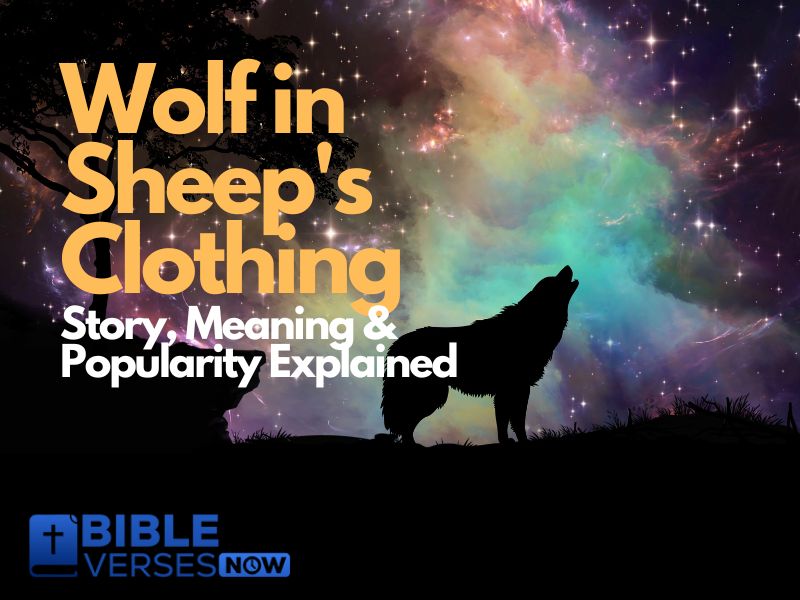The phrase “wolf in sheep’s clothing” is a popular idiom that refers to someone who disguises their true nature or intentions with a harmless appearance. This phrase has inspired various works of art, literature, and music and continues to be relevant in contemporary culture. In this article, we will explore this phrase’s different meanings and interpretations, as well as its origins and popular references.
Definition of “Wolf in Sheep’s Clothing”:
The phrase “wolf in sheep’s clothing” is derived from the Gospel of Matthew 7:15, where Jesus warns his disciples
Matthew 7:15
“Beware of false prophets, who come to you in sheep’s clothing but inwardly are ravenous wolves.”

This passage suggests that false prophets appear outwardly harmless and are deceptive and dangerous. The metaphor of a wolf dressed as a sheep emphasizes that such individuals are not what they seem and that their true nature is hidden behind a façade.
Overview of the Story’s Popularity and Meaning:
The popularity of the phrase “wolf in sheep’s clothing” can be traced back to Aesop’s fables, particularly the story of the wolf dressed in a sheep’s skin who deceives the shepherd and can steal a lamb from the flock. This story illustrates that appearances can be deceiving and that one should be cautious of those who are not what they seem.
In the context of the Bible, the metaphor of the “wolf in sheep’s clothing” is used to warn against false prophets who mislead people with their teachings. The passage in Matthew 7:15 highlights the importance of discernment and urges individuals to look beyond outward appearances to discover a person’s true nature.
6 Facts about the Wolf in Sheep’s Clothing
This article aims to provide a deeper understanding of the meaning of the phrase “wolf in sheep’s clothing” in light of biblical references. By examining the phrase’s origins and its significance in the Bible, readers will gain insight into the importance of discernment and the dangers of deception. Additionally, this article aims to highlight the relevance of this metaphor in contemporary society, where individuals often hide their true intentions behind a benign façade.
1 Origin of the Story
The origin of a story is crucial in understanding its meaning, context, and significance in popular culture. This article will delve into the historical context of the story’s origins, explore its variations in different cultures and periods, and analyze its importance in popular culture.
Historical Context of the Story’s Origins: Every story has a beginning, and understanding the historical context of a story’s origin is vital in understanding its meaning and significance. Many stories have their roots in ancient history, and the Bible is one such source of stories. The Bible is a collection of religious texts central to Christianity and Judaism, and it contains numerous stories passed down through generations.
For instance, Noah’s Ark, found in the book of Genesis, is a well-known biblical story rooted in ancient history. According to the Bible, God saw the wickedness of mankind and decided to cleanse the earth of sin by sending a great flood. God chose Noah, a righteous man, to build an ark and save his family and two of every kind of animal.
Variations of the Story in Different Cultures and Time Periods
Many stories have been adapted and retold in various cultures and periods, and the story of Noah’s Ark is no exception. The great flood story can be found in numerous cultures, such as the Epic of Gilgamesh, which predates the biblical account. A great flood story in Hindu mythology is similar to the biblical one.
Furthermore, the story of Noah’s Ark has been adapted into various forms of media, such as movies, television shows, and books. For example, the children’s book “Noah’s Ark” by Jerry Pinkney retells the story of Noah’s Ark through stunning illustrations, while the movie “Evan Almighty” puts a comedic spin on the story.
Significance of the Story in Popular Culture:
The story of Noah’s Ark has been significant in popular culture for centuries. It has been used as a symbol of hope and salvation, and its message of redemption and righteousness has resonated with people across different cultures and religions.
In addition, the story has been used as a metaphor for various contemporary issues, such as climate change and the environment. For example, the environmentalist movement has adopted the story of Noah’s Ark to warn against the destruction of the natural world and the need for conservation.
Moreover, Noah’s Ark has been referenced in popular cultures, such as songs, art, and literature. For instance, the famous hymn “When the Saints Go Marching In” references Noah’s Ark in the line, “When the sun refuse to shine, Lord, I want to be in that number when the saints go marching in.”
The origin of a story is critical in understanding its significance and meaning in popular culture. Noah’s Ark is an excellent example of a story that has roots in ancient history, has been adapted and retold in various cultures and periods, and has remained significant in popular culture for centuries.
Its message of hope, salvation, and redemption has resonated with people across different cultures and religions. Its relevance in contemporary issues is a powerful symbol of our collective responsibility to protect the environment and the natural world.
Matthew 24:38-39.
“For as in those days before the flood they were eating and drinking, marrying and giving in marriage, until the day when Noah entered the ark, and they were unaware until the flood came and swept them all away, so will be the coming of the Son of Man.” –

2. The Story of the Wolf in Sheep’s Clothing
The story of the Wolf in Sheep’s Clothing is an age-old fable passed down through generations. It tells the tale of a sly wolf who disguises himself as a harmless sheep to prey on his victims. This story has a valuable moral lesson that can be applied to many aspects of modern society.
Plot and Characters
The story begins with a wolf who is hungry and seeks prey. He comes across a flock of sheep and realizes he can easily trick them by disguising himself as a sheep. The wolf uses wool from a nearby sheep to cover himself and successfully blends in with the flock. His disguise fools the other sheep, and he can prey on them individually. However, the wolf’s true nature is revealed when he becomes greedy and tries to attack a sheep that is too large for him to handle. The sheep fights back, and the wolf’s disguise disappears, exposing his true identity.
Moral Lesson and Themes
The moral lesson of the story is that appearances can be deceiving. Just because someone looks innocent and harmless does not mean that they are. The wolf in sheep’s clothing represents people who pretend to be something they are not to deceive and take advantage of others. The story warns us to be careful of those who are deceptive and not to trust people based solely on their appearance.
Another theme in the story is the idea of greed. The wolf’s downfall came when he became too greedy and tried to attack a too-large sheep to handle. This is a warning that greed can lead to one’s downfall and that it is essential to be satisfied with what we have.
Interpretation in Modern Society
The story of the Wolf in Sheep’s Clothing is still relevant in modern society. It warns us to be careful of people who pretend to be something they are not, whether in our relationships or business. We must be aware of red flags and trust our instincts when we sense something is wrong.
The theme of greed is also relevant today, where material possessions and wealth are often seen as the ultimate goal. The story reminds us that greed can lead to our downfall and that being content with what we have is essential.
3. Meaning of the Phrase “Wolf in Sheep’s Clothing.”
The phrase “wolf in sheep’s clothing” is a powerful metaphor that has become an important part of our cultural lexicon. It serves as a warning to be cautious and discerning when dealing with people who may not have our best interests at heart and to look beyond surface appearances to uncover the truth. As Matthew 7:16 says, “You will know them by their fruits.” So let us be wise and discerning in all our dealings and not be fooled by those who deceive us.
Definition and usage of the phrase in literature and everyday language
The phrase “wolf in sheep’s clothing” is a common idiom used to describe someone who appears harmless or friendly on the outside but is dangerous or deceitful. The phrase originates from a Bible verse in Matthew, which warns against false prophets who come in sheep’s clothing but inwardly are ravenous wolves.
Examples of the phrase in popular culture
In literature and everyday language, the phrase is often used to describe people or situations where someone is pretending to be something they are not. This can refer to a range of scenarios, from a charming stranger with ulterior motives to a co-worker who seems friendly but is trying to sabotage you.
Importance of the phrase in understanding deception and trust
The importance of the phrase in understanding deception and trust cannot be overstated. It reminds us to be cautious and discerning, especially when dealing with people who may not have our best interests at heart. It also highlights the importance of looking beyond surface appearances and being willing to ask difficult questions to uncover the truth.
In popular culture, the phrase “wolf in sheep’s clothing” has been used in various ways. For example, it has been used as a title for songs by artists like Set It Off and Fifth Harmony and a book by Christine Warren. In films and television shows, the phrase has been used to describe characters who are not what they seem, such as the villainous Mr. Potter in “It’s a Wonderful Life” or the manipulative Cersei Lannister in “Game of Thrones.”
The biblical origin of the phrase comes from Matthew 7:15, where Jesus warns his followers to beware of false prophets who come in sheep’s clothing but inwardly are ravenous wolves. The verse reminds us to be vigilant and cautious regarding those who speak for God or claim to have our best interests at heart.
4 Popularity of the Story
The story of the wolf in sheep’s clothing has remained popular over time and continues to be referenced in various forms of media, including literature, films, and TV shows. Its enduring popularity can be attributed to its timeless lesson about the dangers of blindly trusting others without knowing their true intentions.
One reason for the story’s continued popularity is its simplicity. The tale is easy to understand, and its message is clear and universally applicable. The story’s lesson about the importance of discernment and not being deceived by appearances has resonated with people throughout history and across cultures.
The story has also had a significant influence on other literary works. Aesop’s fable “The Wolf in Sheep’s Clothing” dates back to ancient Greece and is a variation of the same story. The Brothers Grimm’s “The Wolf and the Seven Young Kids” also draws on similar themes. The story has also been referenced in modern literature, such as George R.R. Martin’s “A Song of Ice and Fire” series, where Littlefinger is called a “wolf in sheep’s clothing.”
Moreover, the story has been used in education and moral instruction for centuries. It is often included in collections of fables and folklore, and teachers use it to teach children about the importance of being cautious and skeptical of those who may not have their best interests at heart. The story is also a cautionary tale for adults, reminding them not to be too trusting or naive in their relationships and dealings with others.
In conclusion, the story of the wolf in sheep’s clothing has endured over time due to its universal message about the dangers of trusting others without knowing their true intentions. Its simplicity and clear lesson have made it a popular reference in literature, films, and TV shows. The story’s influence on other works and its usage in education and moral instruction further highlight its significance as a cautionary tale for all ages.
5. Popular References to the “Wolf in Sheep’s Clothing” Metaphor
The metaphor “wolf in sheep’s clothing” refers to someone or something that appears innocent, harmless, or trustworthy but is, in reality, dangerous, deceptive, or deceitful. The phrase has been used extensively in different contexts, including literature, music, religion, and everyday language, to describe situations where appearances are deceptive and things are not what they seem.
Quotes and sayings related to the metaphor
Many famous quotes and sayings have been coined using the “wolf in sheep’s clothing” metaphor to warn people against deceptive behavior. Some of these include:
“Beware of false prophets, which come to you in sheep’s clothing, but inwardly they are ravening wolves.” (Matthew 7:15, King James Version of the Bible)
“There are people who are wolves in sheep’s clothing, and you know they’re wolves from the start.” (C. JoyBell C.)
“Beware of the false prophets, who come to you in sheep’s clothing, but inwardly are ravenous wolves.” (Matthew 7:15, New American Standard Bible)
“The wolf in sheep’s clothing is feared by the sheep, not the wolf.” (Unknown)
Songs, such as the famous “Wolf in Sheep’s Clothing”
by Set It Off and their lyrics
Many popular songs have used the “wolf in sheep’s clothing” metaphor in their lyrics to describe deceitful or manipulative behavior. One example is the song “Wolf in Sheep’s Clothing” by Set It Off, which includes lyrics such as:
“You’re a wolf in sheep’s clothing You’re a heart attack You’re not what you seem You’re a wolf in sheep’s clothing.”
The song warns the listener to beware of people who pretend to be something they’re not.
Religious References, including the Bible and its interpretation of the phrase
The “wolf in sheep’s clothing” metaphor has deep roots in religious texts, especially in the Bible. In Matthew 7:15, Jesus warns his disciples to “beware of false prophets, who come to you in sheep’s clothing but inwardly are ravenous wolves.” This passage is often interpreted as a warning against false teachers or leaders who appear benevolent but try to deceive and manipulate people for their gain. The metaphor has also been used in other religious texts, such as the Quran and the Bhagavad Gita, to describe deceptive behavior.
Literary works, such as Aesop’s Fables and The Shepherd’s Boy and the Wolf
The “wolf in sheep’s clothing” metaphor has been used in numerous literary works, including Aesop’s Fables and The Shepherd’s Boy and the Wolf. Aesop’s Fables, “The Wolf in Sheep’s Clothing,” tells the tale of a wolf who dresses up as a sheep to deceive the other animals and catch them off guard. In The Shepherd’s Boy and the Wolf, a boy repeatedly cries out that a wolf is attacking his sheep, but when the villagers come to help, they realize he is lying and stop believing him. These stories caution against deception and warn of the consequences of not being truthful.
6 The Many Interpretations of the “Wolf in Sheep’s Clothing” Metaphor
The metaphor “wolf in sheep’s clothing” refers to a deceptive or dangerous person or thing that appears harmless or innocuous. It warns against being deceived by appearances and highlights the need for vigilance and discernment.
Different interpretations of the metaphor, such as a warning against deceit or a call for vigilance
The metaphor has been interpreted in various ways, with different shades of meaning. Some interpretations focus on the idea of deceit, where the “wolf” represents a person who pretends to be kind and trustworthy but is malicious and harmful. Others view the metaphor as a call for caution, emphasizing the need to be vigilant and skeptical of people or situations that seem too good to be true. The message is the same in both cases: don’t be fooled by appearances.
Synonyms and related phrases to “wolf in sheep’s clothing”
Synonyms and related phrases to “wolf in sheep’s clothing” include “Trojan horse,” “snake in the grass,” “faux friend,” “false flag,” and “bait and switch.” These expressions all suggest something or someone hiding their true nature or intentions.
Garbage and ACB’s usage of the metaphor in their works, including “The Trick Is to Keep Breathing” and “Wolf at the Door”
The metaphor “wolf in sheep’s clothing” has been used in various works of literature and media. For example, Ali Smith’s novel “The Trick Is to Keep Breathing” explores the theme of deception and betrayal through the story of a woman who struggles with mental illness and discovers that the people she trusts are not who they seem.
The title of Radiohead’s song “Wolf at the Door” also alludes to the metaphor, with the “wolf” representing a threatening and dangerous presence. Similarly, the late Supreme Court Justice Ruth Bader Ginsburg used the metaphor to describe former President Donald Trump’s nomination of Amy Coney Barrett to the Supreme Court, saying that Barrett was a “wolf in sheep’s clothing” who posed a threat to women’s rights.
Frequently asked Questions on “wolf in sheep’s clothing”
What does wolf in sheep’s clothing mean?
- The phrase “wolf in sheep’s clothing” is a metaphor used to describe someone who appears harmless and benign on the surface but is deceptive and dangerous underneath. It refers to the fable of the wolf, who disguises himself as a sheep to gain the flock’s trust and attack them when they least expect it. In modern usage, the phrase is often used to describe someone who pretends to be kind and trustworthy but is manipulative and deceitful.
How can you tell if someone is a wolf in sheep’s clothing?
Identifying a wolf in sheep’s clothing can be difficult as they are skilled at masking their true intentions and presenting themselves as friendly and trustworthy. However, some signs may indicate that someone is not who they seem. For example, they may be overly flattering or charming but lack sincerity in their words and actions. They may also be quick to take advantage of others, show a lack of empathy or concern for others, or demonstrate a history of dishonest or unethical behavior. It is essential to be cautious and pay attention to red flags, especially when entering new relationships or business arrangements.
What does sheep in sheep’s clothing mean?
The phrase “sheep in sheep’s clothing” plays on the idiom “wolf in sheep’s clothing” and describes someone genuinely kind and innocent with no ulterior motives. Unlike the wolf who pretends to be a sheep to gain access to a flock, a sheep in sheep’s clothing is what they appear to be, with no hidden agenda. It is a positive characterization of someone trustworthy and authentic.
Conclusion:
The “wolf in sheep’s clothing” metaphor has a rich and fascinating history, and its various interpretations remain relevant today. Whether used as a warning against deception or a call for vigilance, the metaphor reminds us to look beyond appearances and stay vigilant.







